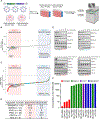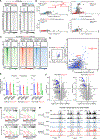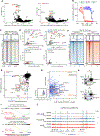Targeting the mSWI/SNF complex in POU2F-POU2AF transcription factor-driven malignancies
- PMID: 39029462
- PMCID: PMC12147762
- DOI: 10.1016/j.ccell.2024.06.006
Targeting the mSWI/SNF complex in POU2F-POU2AF transcription factor-driven malignancies
Abstract
The POU2F3-POU2AF2/3 transcription factor complex is the master regulator of the tuft cell lineage and tuft cell-like small cell lung cancer (SCLC). Here, we identify a specific dependence of the POU2F3 molecular subtype of SCLC (SCLC-P) on the activity of the mammalian switch/sucrose non-fermentable (mSWI/SNF) chromatin remodeling complex. Treatment of SCLC-P cells with a proteolysis targeting chimera (PROTAC) degrader of mSWI/SNF ATPases evicts POU2F3 and its coactivators from chromatin and attenuates downstream signaling. B cell malignancies which are dependent on the POU2F1/2 cofactor, POU2AF1, are also sensitive to mSWI/SNF ATPase degraders, with treatment leading to chromatin eviction of POU2AF1 and IRF4 and decreased IRF4 signaling in multiple myeloma cells. An orally bioavailable mSWI/SNF ATPase degrader significantly inhibits tumor growth in preclinical models of SCLC-P and multiple myeloma without signs of toxicity. This study suggests that POU2F-POU2AF-driven malignancies have an intrinsic dependence on the mSWI/SNF complex, representing a therapeutic vulnerability.
Keywords: IRF4; POU2AF1/2/3; POU2F3; PROTAC; SCLC; SMARCA2/4; mSWI/SNF complex; multiple myeloma; proteolysis targeting chimera; small cell lung cancer.
Copyright © 2024 The Author(s). Published by Elsevier Inc. All rights reserved.
Conflict of interest statement
Declaration of interests A.M.C. serves on the clinical advisory board of Aurigene Oncology Limited. C.A., S.S., and M.R. are employees of Aurigene Oncology Limited. C.R.V. has received consulting fees from Flare Therapeutics, Roivant Sciences, and C4 Therapeutics; he has served on the advisory boards of KSQ Therapeutics, Syros Pharmaceuticals, and Treeline Biosciences. C.R.V. has also received research funding from Boehringer-Ingelheim and Treeline Biosciences and owns stock in Treeline Biosciences. Aurigene Oncology Limited has filed patent applications on AU-15330 and AU-24118. C.M.R. has consulted regarding oncology drug development with AbbVie, Amgen, Astra Zeneca, D2G, Daiichi Sankyo, Epizyme, Genentech/Roche, Ipsen, Jazz, Kowa, Lilly, Merck, and Syros. C.M.R. serves on the scientific advisory boards of Auron, Bridge Medicines, DISCO, Earli, and Harpoon Therapeutics.
Figures





Update of
-
Targeting the mSWI/SNF Complex in POU2F-POU2AF Transcription Factor-Driven Malignancies.bioRxiv [Preprint]. 2024 May 24:2024.01.22.576669. doi: 10.1101/2024.01.22.576669. bioRxiv. 2024. Update in: Cancer Cell. 2024 Aug 12;42(8):1336-1351.e9. doi: 10.1016/j.ccell.2024.06.006. PMID: 38328238 Free PMC article. Updated. Preprint.
Similar articles
-
Mammalian SWI/SNF complex activity regulates POU2F3 and constitutes a targetable dependency in small cell lung cancer.Cancer Cell. 2024 Aug 12;42(8):1352-1369.e13. doi: 10.1016/j.ccell.2024.06.012. Epub 2024 Jul 18. Cancer Cell. 2024. PMID: 39029464 Free PMC article.
-
Targeting the mSWI/SNF Complex in POU2F-POU2AF Transcription Factor-Driven Malignancies.bioRxiv [Preprint]. 2024 May 24:2024.01.22.576669. doi: 10.1101/2024.01.22.576669. bioRxiv. 2024. Update in: Cancer Cell. 2024 Aug 12;42(8):1336-1351.e9. doi: 10.1016/j.ccell.2024.06.006. PMID: 38328238 Free PMC article. Updated. Preprint.
-
KSR1 Mediates Small Cell Lung Carcinoma Tumor Initiation and Cisplatin Resistance.Mol Cancer Res. 2025 Jun 3;23(6):553-566. doi: 10.1158/1541-7786.MCR-24-0652. Mol Cancer Res. 2025. PMID: 39927878
-
PROteolysis TArgeting Chimera (PROTAC) Estrogen Receptor Degraders for Treatment of Estrogen Receptor-Positive Advanced Breast Cancer.Target Oncol. 2025 May;20(3):431-444. doi: 10.1007/s11523-025-01137-5. Epub 2025 May 6. Target Oncol. 2025. PMID: 40327300 Free PMC article. Review.
-
Preclinical evidence in the assembly of mammalian SWI/SNF complexes: Epigenetic insights and clinical perspectives in human lung disease therapy.Mol Ther. 2024 Aug 7;32(8):2470-2488. doi: 10.1016/j.ymthe.2024.06.026. Epub 2024 Jun 22. Mol Ther. 2024. PMID: 38910326 Free PMC article. Review.
Cited by
-
ASCL1 regulates and cooperates with FOXA2 to drive terminal neuroendocrine phenotype in prostate cancer.JCI Insight. 2024 Dec 6;9(23):e185952. doi: 10.1172/jci.insight.185952. JCI Insight. 2024. PMID: 39470735 Free PMC article.
-
Mammalian SWI/SNF complex activity regulates POU2F3 and constitutes a targetable dependency in small cell lung cancer.Cancer Cell. 2024 Aug 12;42(8):1352-1369.e13. doi: 10.1016/j.ccell.2024.06.012. Epub 2024 Jul 18. Cancer Cell. 2024. PMID: 39029464 Free PMC article.
-
Basal cell of origin resolves neuroendocrine-tuft lineage plasticity in cancer.bioRxiv [Preprint]. 2024 Nov 15:2024.11.13.623500. doi: 10.1101/2024.11.13.623500. bioRxiv. 2024. PMID: 39605338 Free PMC article. Preprint.
-
CRISPR screening reveals that RNA helicase DDX41 triggers ribosome biogenesis and cancer progression through R-loop-mediated RPL/RPS transcription.Nat Commun. 2025 Aug 11;16(1):7409. doi: 10.1038/s41467-025-62743-5. Nat Commun. 2025. PMID: 40790042 Free PMC article.
-
SOX2 utilizes FOXA1 as a heteromeric transcriptional partner to drive proliferation in therapy-resistant prostate cancer.bioRxiv [Preprint]. 2025 Jul 19:2025.07.18.664790. doi: 10.1101/2025.07.18.664790. bioRxiv. 2025. PMID: 40791379 Free PMC article. Preprint.
References
-
- Nicholson AG, Chansky K, Crowley J, Beyruti R, Kubota K, Turrisi A, Eberhardt WEE, van Meerbeeck J, and Rami-Porta R; Staging and Prognostic Factors Committee Advisory Boards and Participating Institutions (2016). The International Association for the Study of Lung Cancer Lung Cancer Staging Project: Proposals for the Revision of the Clinical and Pathologic Staging of Small Cell Lung Cancer in the Forthcoming Eighth Edition of the TNM Classification for Lung Cancer. J. Thorac. Oncol 11, 300–311. 10.1016/j.jtho.2015.10.008. - DOI - PubMed
MeSH terms
Substances
Grants and funding
LinkOut - more resources
Full Text Sources
Medical

